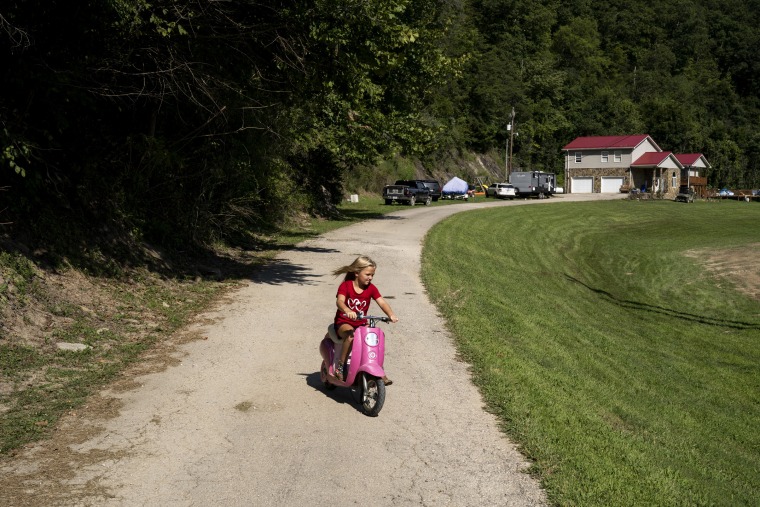HADDIX, Ky. — Isabella Fugate and her husband rushed to get their children to safety and safeguard as many belongings as possible as water filled their home last month. Once the water reached their chests, they gave up. Fugate’s home took on more than 6 feet of water, leaving the dwelling uninhabitable. Fugate, 26, has applied for assistance from the Federal Emergency Management Agency — so far she’s been rejected three times.
Nearly four weeks have passed since historic flooding hit east Kentucky, leaving at least 39 people dead, but many of those applying for help from FEMA in the aftermath say they’ve been stuck in a cycle of rejections and appeals that has only added to the frustration of an already traumatizing ordeal.
Floodwaters brought mud, silt, mold and sludge into homes, turning houses and trailers into unlivable wrecks filled with the ruins of beloved belongings now caked in dirt and grime.
Left homeless, many have been living with neighbors, in campers or in tents near their damaged homes. Entire towns and three counties have been left without access to water after the flood damaged local infrastructure. Residents in Breathitt, Perry and Letcher counties have been told they may not get access to the water system again until December or January.
The Fugates poured their life savings into their home, which is a rent-to-own arrangement, and they only had $70,000 left to pay it off. Now they’re living in a camper outside her mother-in-law’s house with their two young kids. The local circuit clerk wrote a letter in support of their FEMA application, and they provided insurance documents and an affidavit, but it was all denied.
“It’s been so hard, and I don’t want to cry in front of my kids,” Fugate said outside her home. “I don’t want them to see me upset, but I have hit rock bottom with this. I had high hopes for FEMA, but when they turn you down so much, it’s just an aggravating process because you don’t know what to do next.”
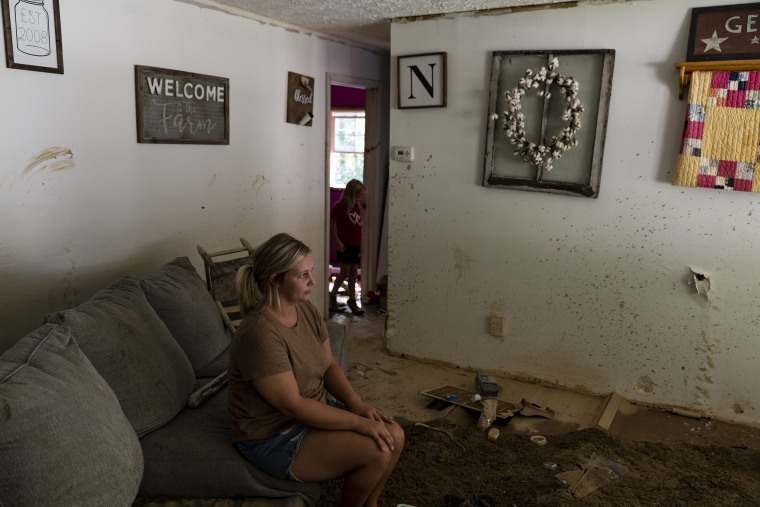
FEMA said that so far it has provided more than $46.8 million in assistance to homeowners and renters hit by the Kentucky flooding. More than 5,900 households have received aid, but there appear to be many more who are struggling with the process and some said the dispersals felt uneven. A few had received the maximum help of $37,900, while others in totally destroyed homes got only a few hundred dollars.
FEMA Press Secretary Jeremy Edwards said the agency intends to “help Kentuckians recover from this disaster for as long as it takes.”
“We want to get this right — we will get this right — and that’s why we are meeting survivors where they are to help them with applications for assistance, documentation submissions and referrals to other agencies and volunteer organizations,“ he said.
A complicated process
Edwards said that a rejection or decision by FEMA does “not necessarily mean the end of the road,” noting that something as simple as a missing document can mean an application cannot be processed. He said that those who have applied to FEMA need to ensure they answer their phone, even if it is coming from an unknown number, as it could be someone clarifying their claim. FEMA Disaster Recovery Centers have also been set up in places close to disaster sites for those with questions, and the agency has sent out inspectors on the ground.
Sherry Bursesh, executive director of disaster relief for Inspiritus, a nonprofit service group, has worked in the disaster area since the early days of the flood. Kentucky is her home state and she’s aware of the state’s unique challenges; in fact she first worked on a disaster site in this same hill country decades ago.
FEMA is often constrained by federal requirements and does the best job it can under the circumstances, Buresh said. But she added that this remote, mountainous region of Kentucky poses a particular challenge to inspectors trying to find and contact people. There is not much trust of the federal government in these hollows, and FEMA officials can often find it difficult to navigate the area’s isolated communities, beset with limited cellphone coverage and broadband.
“A lot of them are just so confused by it all and they’re traumatized already and don’t know where they’re going to sleep at night,” Buresh said. “There’s just so much on the mind and then there’s all this government red tape that people have to get through, and it can feel like too much.”
Kentucky Gov. Andy Beshear, a Democrat, has advised residents not to take FEMA’s first response as a final answer. “Appeal, appeal and appeal,” he said at a news conference this month.
Fugate said she had tried going to one of the recovery centers with her husband, who took a day off from his job at the power company reconnecting homes, costing them much needed money. She said a FEMA representative told her it would take 90 days to approve her application, even though she had been told they could provide an instant approval.
“And then no one can tell me why any of my applications were denied and can’t give me next steps, so you just have to figure it out on your own, and it’s frustrating,” she said.
To receive approval from FEMA, residents have to provide proof of insurance, identity, ownership, occupancy, and that the damaged home is your primary residence. The property also needs to be inspected by the homeowner’s insurance company.
But some said that applying for help is already demoralizing, but continuing to appeal, navigating federal bureaucracy and figuring out how to cut through red tape while living through the trauma of a natural disaster that wiped out your home can feel impossible.
Living without water
Meanwhile, those who don’t have an operable well have to travel to places where volunteer organizations have set up mobile public showers and laundromats.
It’s busiest at the end of the day when people have finished working on their homes.
“I thought I’d be able to come over here and read my book, but no, no, no — it’s busy,” said Dodie Turner, a retired teacher who volunteered to clean and take care of the temporary showers and laundry areas in Buckhorn, Kentucky, a small town that saw its school take on 8 feet of water.
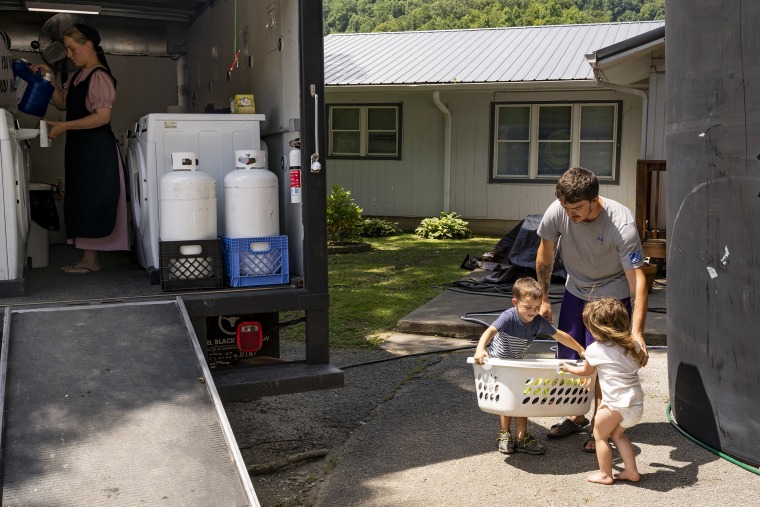
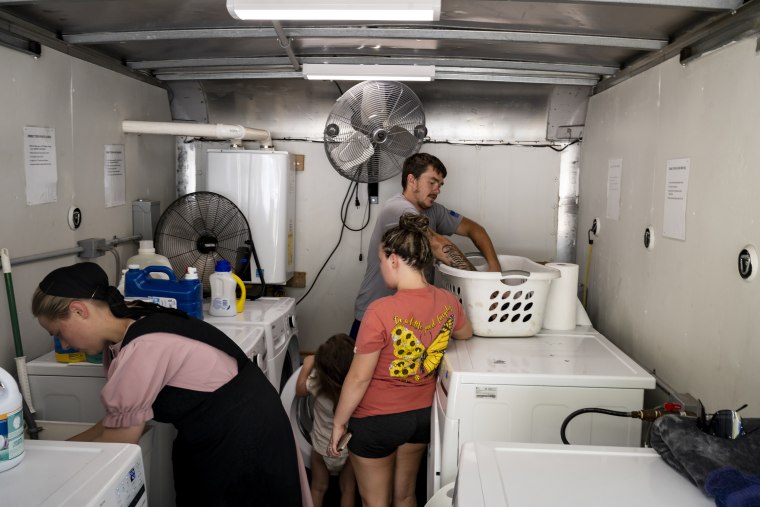
Helen Combs, 79, dropped by the mobile location in Buckhorn from her home on Squabble Creek Road, a narrow thoroughfare that cuts along a mountainside, to take a shower. She’d spent the past few days digging out a mudslide that had come to the door of her home, which is perched at the top of a ridge.
She said her son-in-law had worked to repair a pump to an old well that was outside her home. The water was a bit sandy at first, but they hoped that would get them through the fall.
“I haven’t gotten any updates on the water since they told us it would take three months or so,” Combs said. “It’s been bad, but there’s been groups coming in from different states to help out, so maybe it’ll be sooner.”
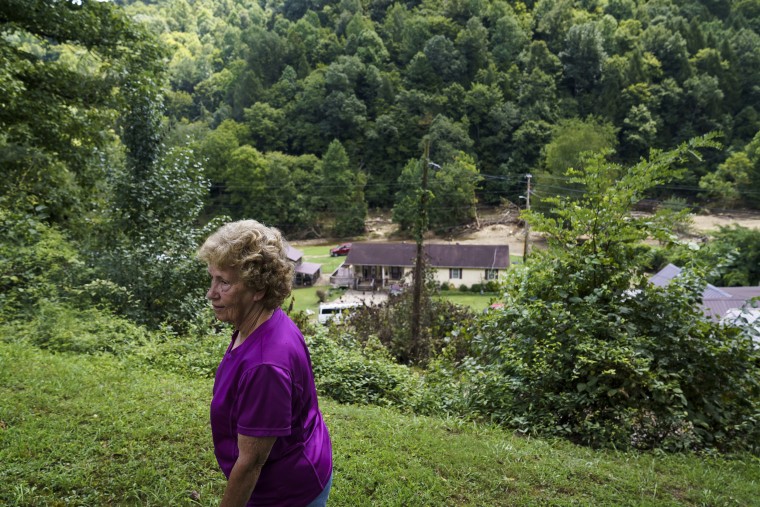
Water and housing will continue to remain a major challenge in East Kentucky, one of the most impoverished regions in the country. Some are concerned, however, that much of the country has already moved on.
Buresh emphasized that the area still needs a large amount of help. Though she’s worked in dozens of disaster zones, she said this one posed a particular challenge because of the region’s poverty and remoteness.
“This is long from being taken care of. It may have fallen out of the news, but it’s by no means over with,” Buresh said. “The people here are resilient, and they’re doing everything they can right now to survive, but we can’t forget they’re also traumatized and grieving.”
